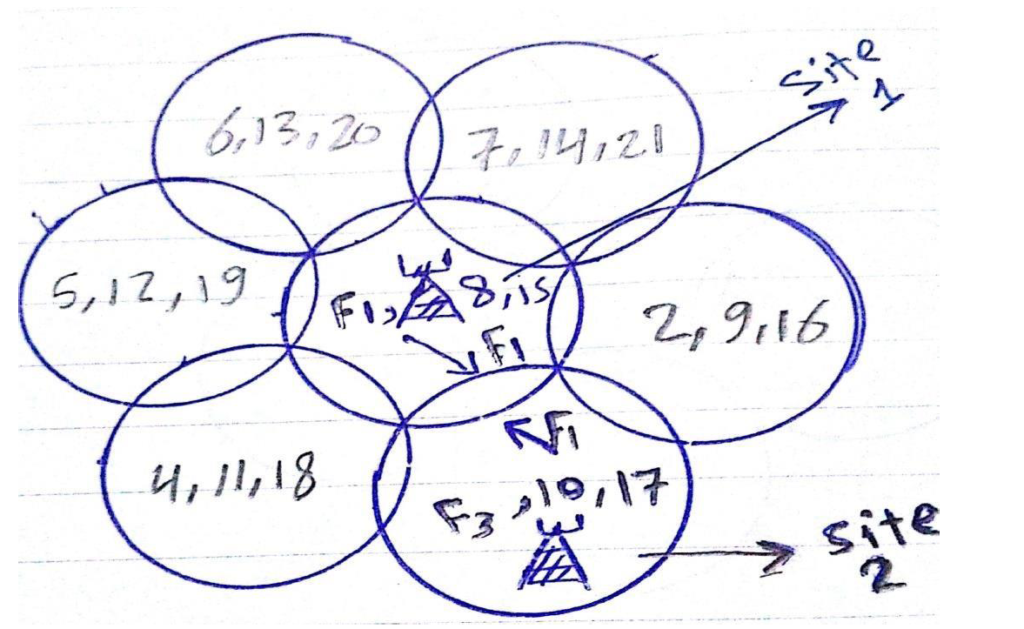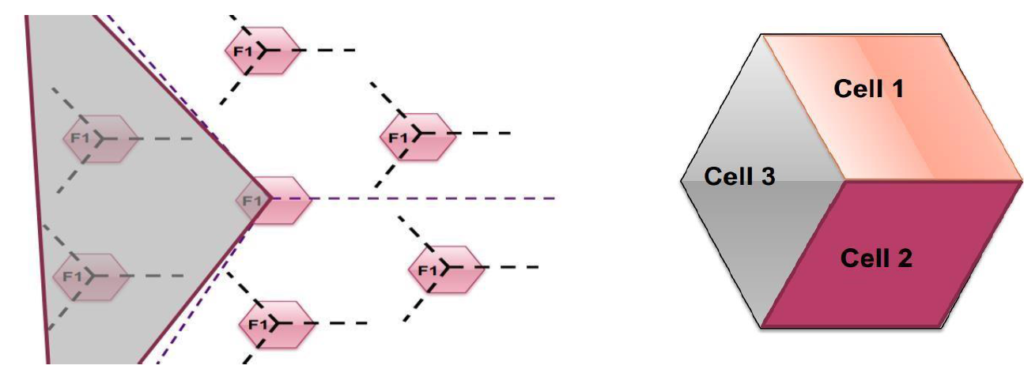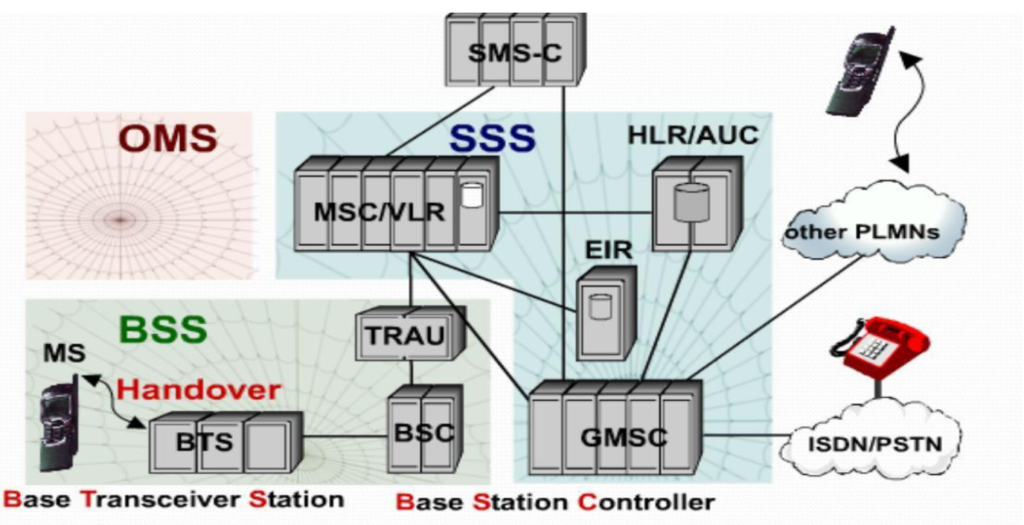Q1) How we can use the same frequency like (F1) in two neighbor cell (site) in the same cluster but do not have interference??
Answer) We can do this by we reduce the power of the frequency (F1) in two sites than other frequencies, this mean that the coverage area of frequency (F1) have small area than each frequencies in cell ,this mean that we do not find interference between two frequencies (F1) between two cells(sites).

Question: what are difference between co-channel interference and adjacent channel interference??
For co-channel interference: this do between the same two frequencies like (F1 & F1) at neighbor cluster .we can solved this problem by cell sectorization.

For adjacent channel interference: this do between different frequency like (F1 & F2). We can solved this problem by channel mangment {do not put sequence frequencies in the cell like (F1 & F2 & F3 ) but put in cell (F1 & F8 & F15) }

Question: Draw GSM network and explain every part??

Mobile equipment (ME)
➢it is the terminal used by user
➢Can be purchased from any store
➢Without SIM no calls can be made
➢It has an International Mobile Equipment Identity (IMEI)
The Base Transceiver station (BTS)
➢BS contains the RF transmission equipment
➢It has an International cell global Identity (CGI)
➢It performs
➢Power amplification
➢channel coding
➢ciphering
➢modulation
The base station controller (BSC)
It carries out all control functions in the BSS as:
- Paging
- Channel allocation
- Dynamic power control
- Handover
The transcoding and rate adaptation unit (TRAU)
It is used for speech compression/decompression – Also adaptation of data to the requirement of the air interface.
The Mobile service switching center (MSC)
-It is an electronic computerized exchange provides the interface between MS and the fixed network -It will not contain any subscriber parameters
- Switching.
- Charging.
- call routing.
- Communication with HLR and VLR.
- Communication with other MSCs.
- Control of connected BSCs.
The MSC is connected to:
- HLR (Home location register)
- VLR (Visitor location register)
- AUC (Authentication Center)
- EIR (Equipment identity register)
HLR (Home location register)
The centralized database that stores and manages all mobile subscription parameters – HLR contains :
➢ Subscriber identification numbers (IMSI,MSISDN)
➢ Subscriber current location information (MSC/VLR)
➢ Subscriber authentication information
➢ Charging
➢ Billing method
VLR (Visitor location register)
A temporary storage location for subscription information for MSs which are within MSC service area.
VLR contains :
➢ Mobile status (free, busy,…etc)
➢ Temporary MS identity (TMSI)
➢ Temporary MS roaming number (MSRN)
➢ Location areas
➢ Supplementary service information
Authentication
It is a processor system that performs the authentication function.

EIR (Equipment Identity Register)
As the subscriber and equipment are separate in GSM so we use a separate authentication process for MS equipment.
- EIR is a centralized database for validation of (IMEI).
- EIR contains 3 lists:
➢ White list (for valid MS equipment)
➢ Black list (for stolen or denied service MS)
➢ Gray list (for mal- performance MS
[e.g. faulty software] )
Operation and maintenance center (OMC)
A-The Operation and Maintenance Center for Radio part (BSS) (OMC- R).
B-The Operation and Maintenance Center for switching parts (OMC- S).
Question: why we measure the quality and power of my cell but measure the power only of neighbor cell?
In general (Power α quality ) but in some time we find that we have a good power but the quality is bad(poor) because we have interference at this channel so we must measure the quality by bit error rate of information (signal) , and if we find the quality bad we must increase the power.
But we cannot measure the quality of neighbor cell because we cannot connected (access) to this cell because we measure the quality by bit error rate of signal and at this cell no signal between my mobile and this cell, but measure power for handover.
Question: Is it possible to dispense of VLR or HLR??
We possible dispense VLR, but we cannot dispense HLR because it is database of basic information for users.
Question: If we have two users do a call at the same place and have the same type of mobile, List possible reasons why one mobile ongoing call and another cannot ongoing call??
1- we find a failure in unit of user at HLR.
2-Rach congestion, this mean one of user request random access and success, but the another user request random access and do collision with another user.
3-one of user takes the last SDCCH free and takes the last traffic channel, so another user cannot do a call because it cannot find any SDCCH free and any traffic channel.
Question: why we use numbers of VLR not we use only one VLR??
Because VLR store large temporary information and if we put them in one VLR we must need big database and the load at VLR is large.
Question: why we use downlink at high frequency and use uplink at low frequency??
Because if frequency is increase the losses is increase, so we must increase the power for overcome the losses, but we increase the power at base station not mobile, and we at base station use(send) downlink not uplink.
Question: If we have two microwave dishes and we need to linked them to each other (large distance), can we use low frequency or high frequency??
We must use low frequency, because: it has low losses and we need enough (suitable) power, but if we use high frequency it has high losses and we need high power, so we use the high frequency at small distance.
Question: If we at a site and possible connect to 900MHZ and 1800MHZ, is the MSC give us 900MHZ or 1800MHZ??
The MSC give us 1800MHZ, because the band of 1800MHZ has small coverage area and have high losses than 900MHZ, and we leave the band of 900MHZ for remote users, because the band of 900MHZ has large coverage area.
Queston: Which is better band of 900MHZ(GSM) or 1800MHZ(DCS)??
900MHZ (GSM) have large coverage area so it uses at Large open spaces.
1800MHZ (DCS) have small coverage area so it uses at inside buildings, because the pentration of buildings at 1800MHZ is good.
Question: Why we store IMEI of mobile in flash memory not ROM??
Because, if the chip of ROM in mobile is distorted we cannot replace it by another ROM and we cannot write IMEI at this new ROM, because: the ROM are nonvolatile memory.
But if the chip of flash memory in mobile is distorted we can replace it by another flash memory and we can write IMEI at this new flash memory, because: the flash memory is volatile memory.
Question: When BS known the value of distance (delay) it tell the mobile the value of distance, is the BS work by this timing advance (use same distance of mobile) or use another method for known this distance (delay)??
At downlink no timing advance, this problem of delay not at downlink but this problem at uplink, because at downlink we have only BS that transmit to all users by sequence, so we have not any collision but at uplink we have many users are transmit to BS at the same time so have a collision result of delay so we need timing advance.
Question: why the power is separate in uplink and downlink??
Because we operate in GSM by FDD, this mean that the uplink have operate at frequency and downlink operate at different frequency, and we know when the frequency increase the losses is increase, so the power at uplink is different at downlink.
Question: what is the measurement report??
The MS measures downlink:
Signal strength (dBm).
Signal quality (BER).
Signal strength of neighboring BTSs downlink.
The BTS measures UpLink:
Signal strength received from MS.
Signal quality received from MS. Distance between BTS and MS
Question: what is the call scenario??

1-the mobile send request to BTS for do a call, but BTS not have any decision so this request send to BSC, and this request send through random access channel (RACH).
2- BSC looking for SDCCH is free and available, and then sent the information of this channel (SDCCH) to BTS, and then BTS send this information to mobile through (AGCH).
3- the mobile use SDCCH for authentication.
4-if the user is success in authentication the BSC looking for free traffic channel and then send the information of this channel to BTS, and then BTS send this information to mobile.
5- MSC do call routing.

1-user is call another user using dialable number through, the dialable number send to local exchange, and then sent to gateway of operator, but gateway it want know the location area for do paging and then forward the call to the user, we know the LA through (MSRN) and (MSRN) is stored in VLR, but the gateway do not know VLR, so firstly gateway must ask HLR.
2-the gateway are ask HLR for give me (MSRN) of user.
3- HLR is takes MSISDN (dialable number) and give IMSI.
4-HLR is sends IMSI to VLR of user and request from VLR to give (MSRN) of the user.
5-VLR is show (MSRN) and sent it to HLR, and then HLR sent it to gateway, and when gateway is see (MSRN) it know the user where the location area and therefore know the MSC.
6-gateway is connects to MSC of user and MSC is connect to the BSC of user.
7-VLR of user is takes the (MSRN) and give (TMSI).
8-BSC is sends (TMSI) of user to all BTS in network for do paging through (PCH), and then mobile of user is ack the paging and sent the response through (RACH).
9-if BTS know the user it sent stop paging.
10-BSC looking for (SDCCH) is free and then sent the information of (SDCCH) to BTS and then the BTS sent information to mobile through (AGCH).
11-if the mobile know the information of (SDCCH), it use the (SDCCH) and do authentication, and if it success forward the call.
Question: what are the interfaces between elements in GSM network??
between MS – BTS — > UM interface
between BTS – BSC — > Abis interface
between BSC – MSC — > A interface
between HLR – VLR — > D interface
Question: What is the type of modulation in GSM??
Gaussian Minimum Shift Keying (GMSK) is the modulation scheme of the GSM system.
We use GMSK because ( 1, 0 ) in frequency domain is converted to sinc function.
Sinc function have large bandwidth, so this do interference with the another wave, so we use GMSK for remove side loop and take the main loop by using low pass filter. The main loop is haves large power of signal.

Question: what is means discontinuous transmission??
Users cannot speak all time during the call, so we find silence periods and we can use this periods for saving power.
When the users silence the transmission do not stop Instantaneous, but the transmission continuous small time for known the silence is Instantaneous or this silence is longer. If transmission known the silence is longer it is stop and sends small noise (silence description (SID)) to user for the BS know the call is work not stop.

Question: what is the frequency band are used in GSM??
900MHZ and 1800MHZ
Question: What is the packet switching domain??
Packet switching domain mean that (PCU, SGSN, GGSN) circuit switching domain mean that (BSC, MSC+VLR, GMSC)
PCU: packet control unit, it is Corresponds like BSC in circuit switching domain. It used for:
• Channel request and assignment
• Power control
• Handover decision
• Retransmission decision
SGSN: serving GPRS support node, it corresponds like (MSC+VLR) in circuit switching domain. It used for routing and switching in my network and used for:
•mobility management: do attach, detach and area updating.
•security
• Authentication: data are separately on GSM (voice), so data have authentication differ than authentication of voice and have differ registration.
• Ciphering
The cause of early ciphering in the GPRS network
• the security of the transmission increases
• it will not be necessary to reconfigure all existing Base
Transceiver Stations
• Billing (in my network)
GGSN: gateway GPRS support node, it corresponds like (GMSC) in circuit switching domain. It used for connect my network with another different networks.
- Screening (Firewall): monitoring everything in network and protection the component from attacker.
- Routing
- Billing (for another network)
- Protocol translation
Question: what is the type of modulation used in EDGE and can we increase the modulation order??
The modulation used in EDGE is (8PSK). It use three bit for represent of symbol, so we have 8 phase shift.

We cannot increase the modulation order, because if we increase the order of modulation the rate is increase and the probability of errors (POE) is increase, this mean that the signal will have large number of errors and distorted the signal.
